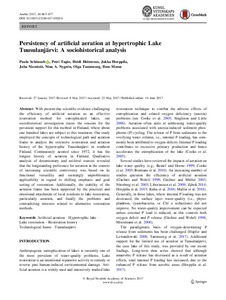| dc.contributor.author | Juha Niemistö | |
| dc.contributor.author | Paula Schönach | |
| dc.contributor.author | Olga Tammeorg | |
| dc.contributor.author | Ilmo Massa | |
| dc.contributor.author | Nina A. Nygrén | |
| dc.contributor.author | Petri Tapio | |
| dc.contributor.author | Jukka Horppila | |
| dc.contributor.author | Heidi Holmroos | |
| dc.date.accessioned | 2022-10-27T12:14:41Z | |
| dc.date.available | 2022-10-27T12:14:41Z | |
| dc.identifier.uri | https://www.utupub.fi/handle/10024/157272 | |
| dc.description.abstract | With present-day scientific evidence challenging the efficiency of artificial aeration as an effective restoration method for eutrophicated lakes, our sociohistorical investigation traces the reasons for the persistent support for this method in Finland, where about one hundred lakes are subject to this treatment. Our study employed the concepts of technological path and aeration frame to analyze the extensive restoration and aeration history of the hypertrophic Tuusulanjarvi in southern Finland. Continuously aerated since 1972, it has the longest history of aeration in Finland. Qualitative analysis of documentary and archival sources revealed that the longstanding preference for aeration in the context of increasing scientific controversy was based on its functional versatility and seemingly unproblematic applicability in regard to shifting emphasis and goal setting of restoration. Additionally, the stability of the aeration frame has been supported by the practical and emotional attachment of local residents to lake restoration, particularly aeration, and finally the problems and contradicting interests related to alternative restoration methods. | |
| dc.language.iso | en | |
| dc.publisher | SPRINGER | |
| dc.title | Persistency of artificial aeration at hypertrophic Lake Tuusulanjärvi: A sociohistorical analysis | |
| dc.identifier.url | https://link.springer.com/article/10.1007/s13280-017-0926-6 | |
| dc.identifier.urn | URN:NBN:fi-fe2021042717448 | |
| dc.relation.volume | 46 | |
| dc.contributor.organization | fi=tulevaisuuden tutkimuskeskus (FFRC)|en=Finland Futures Research Centre (FFRC)| | |
| dc.contributor.organization-code | 2608900 | |
| dc.converis.publication-id | 27431369 | |
| dc.converis.url | https://research.utu.fi/converis/portal/Publication/27431369 | |
| dc.format.pagerange | 865 | |
| dc.format.pagerange | 877 | |
| dc.identifier.eissn | 1654-7209 | |
| dc.identifier.jour-issn | 0044-7447 | |
| dc.okm.affiliatedauthor | Tapio, Petri | |
| dc.okm.affiliatedauthor | Nygren, Nina | |
| dc.okm.discipline | 519 Yhteiskuntamaantiede, talousmaantiede | fi_FI |
| dc.okm.discipline | 519 Social and economic geography | en_GB |
| dc.okm.internationalcopublication | not an international co-publication | |
| dc.okm.internationality | International publication | |
| dc.okm.type | Journal article | |
| dc.relation.doi | 10.1007/s13280-017-0926-6 | |
| dc.relation.ispartofjournal | AMBIO: A Journal of the Human Environment | |
| dc.relation.issue | 8 | |
| dc.year.issued | 2017 | |
